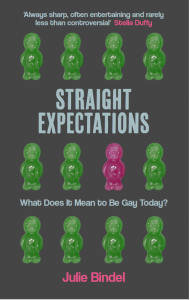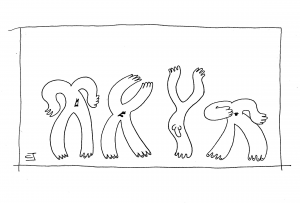Whose story is it anyway? 1
The stewardship of feminism’s collective memory raises all kinds of ethical questions. Can our approach be based on trust alone? Frankie Green shares some thoughts on feminism, archiving and accountability.
No need to hear your voice when I can talk about you better than you can speak about yourself. No need to hear your voice. Only tell me about your pain. I want to know your story. And then I will tell it back to you in a new way. Tell it back to you in such a way that it has become mine, my own. Re-writing you, I write myself anew. I am still author, authority. I am still the colonizer, the speaking subject, and you are now at the center of my talk (bell hooks, Yearning: Race, Gender and Cultural Politics).
The context in which bell hooks writes is very different from mine. Yet her words resonate strongly with me, illuminating some questions I want to explore here.
Archiving the history of the WLM is well-established, as we who experienced that era believe it crucial to ensure that our movement is not lost to history. The importance of taking this task seriously has been elucidated by Jalna Hanmer, and many have worked tirelessly on collecting and cataloguing information, making it available to new generations of activists, students and historians. Our collections provide insights into the aims, achievements and processes of the movement and show how it was sustained at grassroots level by thousands of women – many of whom did not become well-known, since they never attracted the attention of the mainstream media.
We want these archives to be seen not as reliquaries, but as resources in our ongoing struggles, useful in the continuing quest for the ending of women’s oppression. As I said when speaking on behalf of the Women’s Liberation Music Archive (WLMA) in the workshop ‘Archives and Activism: Knowing our Past – Creating our Future’ at 2014’s Feminism in London conference, they ‘are not about preserving history in aspic, or rosy-tinted nostalgia.’ WLMA documents feminist music-making in the 1970s/80s, and is the fruit of discussions among musicians and activists who generously donated time, money and material in the belief that it’s important to illustrate the role of culture within political movements. It complements other feminist archives.
But while there’s a consensus that such archiving is important, I haven’t come across much discussion regarding the subsequent use made of these archives. I have become interested in issues raised by this usage, the value created by it and the process of its production.
Ethics and interpretation
The ethics of archiving appear self-evident: responsibility to those who make the collections possible; respect for the holdings and their provenance, integrity and placement; adherence to written or verbal agreements between parties; good practice regarding a professional standard of behavior (including amongst amateurs/volunteers). Such codes of conduct are affirmed by various professional bodies, including the International Council on Archives, which states:
archivists should not collect original documents or participate in any commerce of documents on their own behalf. They should avoid activities that could create in the public mind the appearance of a conflict of interest
What recourse is available to us if such codes are not adhered to? Are there additional, specific principles that feminists need to incorporate into our practice?
These questions point to some wider issues relating to the interpretation of feminist history.
In her 1966 essay Against Interpretation, Susan Sontag said that interpretation
presupposes a discrepancy between the clear meaning of the text and the demands of (later) readers. It seeks to resolve that discrepancy … Interpretation is a radical strategy for conserving an old text, which is thought too precious to repudiate, by revamping it. The interpreter, without actually erasing or rewriting the text, is altering it. But he [sic] can’t admit to doing this. He claims to be only making it intelligible, by disclosing its true meaning.
Interpretation creates another layer of temporality and text. Print media acquire legitimacy, being mostly less ephemeral than other forms, bestowing a mantle of authority on writers. Published books acquire credibility, as anyone who’s challenged the texts used on Women’s Studies courses knows. Myriad implications are involved, meaning that this creation of a secondary layer of theorizing and analysis is worth attention. How is this creation achieved? What does it leave out or invisibilise? What checks can be used for verification of data presented? And the age-old question: cui bono – who benefits?
It is unfortunate that amongst people who have contributed oral or written histories to collections, the experience of having their work or words misrepresented or quoted without permission seems to be quite common. I know of some who feel exploited by researchers who have behaved less than honourably or betrayed the trust placed in them. Donors have cooperated with authors only to find the ensuing publications disappointing or inaccurate. If people have not been consulted or if they feel their own narratives have been taken from them, they are left with a sense of disillusionment.
Disputes frequently arise, and enter public discourse; one recent example concerned a book about the IRA hunger striker Bobby Sands which was produced without consulting his family about the accuracy of the portrayal of his life. The cultural appropriation of people’s history on a greater scale is a longstanding unethical practice affecting indigenous people, exemplified by the use of sacred Native American myths in Peter Nabokov’s publication ofThe Origin Myth of Acoma Pueblo. The issue of ownership arises, as in the question asked of me by a woman who found herself quoted in a book by an author who had misled her: ‘whose story is it anyway?’
Claiming our own histories
Many of us have had to assert a claim to our own histories. It is understood that memory may be fallible, narrators unreliable and, of course, the field of oral history contains many pitfalls. The standpoint of personal experience has been challenged for its claim to epistemological privilege and authenticity. Nevertheless, there is significance in the fact of having been there: of being present at, participating in and causing actual events to which we ascribe meaning and of which we have clear recollections. Having our stories regurgitated in an unrecognisable form is a galling experience. As a mature student in the 1980s, I found myself disagreeing with tutors confident they knew the truth about WLM events of the previous decade – events in which I had taken part. Lived experience lost out in competition with what had become received wisdom. It is disorientatingly unpleasant to feel like a ghost in one’s own story; a kind of cognitive dissonance occurs.
Those of us from that era hope to ensure our stories are accurately represented. Which begs the question of whether we need others to tell those stories and republish them into the world. We were there; we are the experts in our own lives. Do we need interpretation to ‘disclose … true meaning’? And what do we do if an interpreter fails to consult us or has an outlook with which we disagree?
Perhaps the campaigning maxim of ‘nothing about us without us’ needs to be borne in mind. Many people now insist on a caveat ensuring that they retain the right of veto, that they see what is written about them prior to publication. To provide that option may seem a matter of common courtesy, but it does not always happen. In such cases, as with an unauthorised biography, readers need to be aware of issues arising from the lack of consent and that the veracity or reliability of the account may be in question. Editors and publishers rely on their authors acting in good faith, but perhaps they also have a pro-active role to play. Do authors have a responsibility to inform people and organisations that they are being written about? How do our moral criteria as feminists differ from general notions of ethics, if at all?
Of course, the meaning of stories cannot be controlled, and it is not necessarily desirable that they be so; we need to be able to let them go, and hope they will be treated ethically. We can disassociate ourselves if an account is found to be inaccurate or misleading, though of course pre-empting such a thing happening in the first place would be preferable. Feminist projects frequently depend on goodwill; it is to be hoped that negative examples are rare.
We can adopt guidelines, codes, standards of behavior, but the question of enforceability remains. How do we resolve moral dilemmas, rather than rigidly policing, if we wish to work non-hierarchically? How can problems be addressed, not to punish, but to prevent unethical behaviour, and in a professional way, taking care to avoid a descent into trolling and trashing?
Academic careers and capital can be built on the work of others, both original creators of material and those who have collected and curated it. There is nothing inherently wrong with this; indeed, the desired outcome of making material publicly available is that users will find it valuable for exploration and exegesis. WLMA has constructive interactions with students who find us useful, as we hoped. There’s reciprocity involved and it’s positive when they make their writings available to us in turn to be archived. Less responsible researchers can cause disillusionment. Perhaps the need for funding can be corrupting, in the scramble to secure it corners are cut, principles relaxed. We expect exploitation from the capitalist marketplace ripping the world apart as it monetises every last thing, but can only hope it does not prevail in the sphere of feminism.
To see one’s writings reprinted or actions written about, when one would not wish them to be so used, is to feel colonised. Under colonisation, a territory’s original inhabitants’ inherent value is less than that which they produce for those taking it over. This throws into sharp relief the difference between intrinsic worth – dignity, rights, inalienable personhood – and extractable, appropriated value. Attitudinally, it’s like the difference between respect and contempt, care and indifference. The momentum that carries colonisers along normalizes their actions, but they make conscious choices for which they are responsible.
A coloniser likes to take over not simply a terrain’s resources and the labour of the inhabitants, but control of the narrative, inscribing their own being into the story that is already there. Setting themselves up as expert and writing in an ostensibly authoritative manner allows disregard for the subjectivity of the people of whom they write. The colonised subject struggles then not only to regain material control but for recognition of more nebulous aspects of the problem: attachment to their history and culture, the personal meaning of an era in a lifetime – the emotions which inform their resistance against exploitation.
The coloniser also casts themselves as the discoverer, intrepid explorer opening up unknown realms, an academic maverick boldly going where no researcher has gone before. For the people who are already there of course this knowledge is not new, as they are already know it, indeed created it. Sometimes the person already there is friendly, not sceptical, having no reason for suspicion, only later regretting the openness which facilitated their own exploitation. Then their resistance to being taken over is an obstructive nuisance; they have the temerity to be insufficiently grateful.
Feminists are not a dispossessed ethnic group, our memories or memorabilia are not sacred texts or artefacts, our narratives are not arcane. But it can widen our debate to consider different ways of regarding intellectual property ownership that co-exist in the world. There are models which augment the western legal one regarding protocols, wherein the less technical aspects are valued, elements harder to quantify – intangibles like respect, trust, integrity. Publicly available material can be used under the principle of Fair Use, but that does not grant license to plunder it at will regardless of people’s feelings and wishes. Having no compunction about assuming an entitlement within such narrow strictures, leaving out these other factors, would be self-servingly convenient. Challenging the right assumed by Nabokov and other white authors to retell Acoma Pueblo stories, Fred S. Vallo Sr., discussing cultural property rights, concludes that ‘we like to tell our own story. Let us do it.’
Still here
The contents of archives can be viewed as part of what Bernard Steigler has conceptualized as constituting the ‘already-there’, using a theoretical framework drawn on, for instance, by Deborah Withers in the book Feminism, Digital Culture and the Politics of Transmission. But however useful such analyses may be, in relation to the documentation of feminist history perhaps what needs to take priority is the ‘still-here’: us. Real women engaged in active processes of being, women who embody the political consciousness of that time, who inhabited the ‘structures of feeling’ of its lived experience, to borrow Raymond Williams’ phrase. Though sadly some of us are no longer here, many of us are still alive and very much kicking, carrying on doing what we’ve always done – and archiving our own history.
I’m suggesting that setting up grassroots projects to do this work without incorporating a formal code of conduct–basing the work on trust alone–may not ensure that our history is safeguarded. Stewardship of collective memory needs to continue to be done with care, always bearing in mind the actual women with whose stories we are entrusted, with respect and transparency as guiding principles.
It would be ironic if women whose work is claimed as feminist heritage, who made possible the very context in which today’s researchers work, felt the latter were careless of upsetting or alienating them. What price feminist scholarship or academic careers if they rest on the invisible labour of people who feel they have been treated unethically or indifferently? It would be nonsensical to treat people’s creations as more valuable than the people themselves. If our histories, ourselves, our politics, are worth taking seriously, then surely so must be the moral parameters deployed in chronicling them.
Frankie Green is the Administrator of the Women’s Liberation Music Archive: https://womensliberationmusicarchive.co.uk




